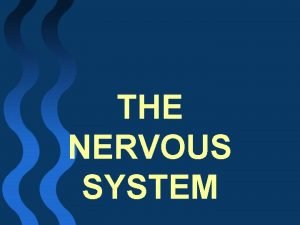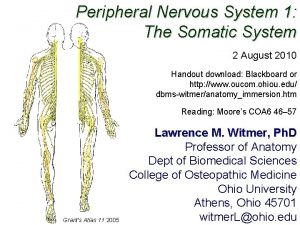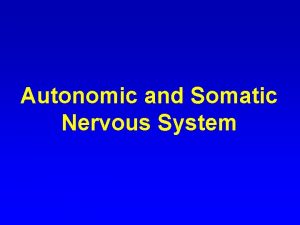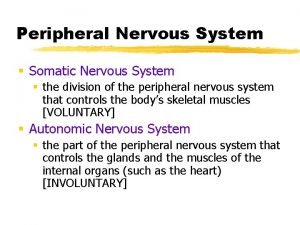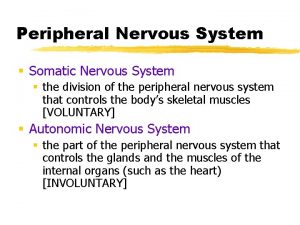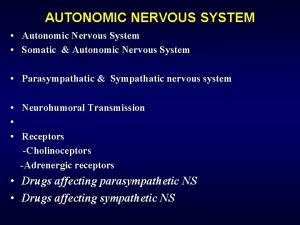Nervous system Somatic Sensations II Pain Headache and
















- Slides: 16

Nervous system Somatic Sensations: II. Pain, Headache, and Thermal Sensations

1 -Types of pain and their qualities: Cutaneous fast pain and throughout slow pain 2 - free nerve ending for pain receptors 3 - mechanical, thermal, and chemical pain stimuli: bradykinin, serotonin, histamine, potassium ions, acids, acetylcholine, and proteolytic enzymes. prostaglandins and substance P enhance the sensitivity of pain endings but do not directly excite them. 4 - No adapting Nature of Pain Receptors

Causes of pain: 1 - Heat (>45) and tissue injury through the chemicals: intensity of pain is also closely correlated with the rate of tissue damage from causes other than heat, such as bacterial infection, tissue ischemia, tissue contusion, and so forth. 2 - ischemic pain through the lactic acid 3 - muscle spasm through the mechanical compression and ischemia

DUAL PATHWAYS FOR TRANSMISSION OF PAIN SIGNALS INTO THE CENTRAL NERVOUS SYSTEM 1 - Neospinothalamic Tract for Fast Pain 2 - paleospinothalamic tract for slow pain

slow-chronic pain signals project mainly into the brain stem and thalamus pain perception and appreciation interpretation in RF and thalamus interpreting pain quality mainly in cortex poor capability of precise localization ************************** fast-acute pain signals project mainly into thalamus and in a less extent to the brain stem Relative capability of precise localization specially when tactile receptors that excite the dorsal column–medial lemniscal system are simultaneously stimulated, the localization can be nearly exact

Pain suppression (analgesia) system in the brain and spinal cord The analgesia system consists of three major components: (1) The periaqueductal gray and periventricular areas of the mesencephalon (2) the raphe magnus nucleus, a thin midline nucleus located in the lower pons (3) a pain inhibitory complex located in the dorsal horns of the spinal cord Sites of external opiate action

Descending monoaminergic pathways regulate nociceptive relay neurons in the spinal cord

Inhibition of Pain Transmission by Simultaneous Tactile Sensory Signals Definition: stimulation of large-type Aβ sensory fibers from peripheral tactile receptors can depress transmission of pain signals from the same body area. Mechanism: local lateral inhibition in the spinal cord. Excitement and aquapuncture: This mechanism and the simultaneous psychogenic excitation of the central analgesia system are probably also the basis of pain relief by acupuncture. Treatment of Pain by Electrical Stimulation of skin or thalamus and PAG, PVN stimulate the dorsal sensory columns

Referred pain Often a person feels pain in a part of the body that is fairly remote from the tissue causing the pain. This phenomenon is called referred pain. For instance, pain in one of the visceral organs often is referred to an area on the body surface. Knowledge of the different types of referred pain is important in clinical diagnosis because in many visceral ailments the only clinical sign is referred pain. Mechanism: converging visceral pain signal on skin pain signal

Visceral pain 1 - Pain from the different viscera of the abdomen and chest is one of the few criteria that can be used for diagnosing visceral inflammation, visceral infectious disease, and other visceral ailments. 2 - the viscera have sensory receptors for no other modalities of sensation besides pain. 3 - Damage to viscera don’t generate pain, Conversely, any stimulus that causes diffuse stimulation of pain nerve endings throughout a viscus causes pain that can be severe

Causes of True Visceral Pain 1 - ischemia: because of the formation of acidic metabolic end products or tissue degenerative products such as bradykinin, proteolytic enzyme 2 - chemicals: proteolytic acidic gastric juice may leak through a ruptured gastric or duodenal ulcer. This juice causes widespread digestion of the visceral peritoneum 3 - Crampus spasm: Spasm of a portion of the gut, the gallbladder, a bile duct, a ureter, or any other hollow viscus through the mechanical stimulation of pain receptors od ischemia 4 - overdistention like spasm generate pain Insensitive Viscera parenchyma of the liver and the alveoli of the lungs. Sensitive area in insensitive visera the liver capsule is extremely sensitive to both direct trauma and stretch, and the bile ducts are also sensitive to pain. In the lungs, even though the alveoli are insensitive, both the bronchi and the parietal pleura are very sensitive to pain.

“PARIETAL PAIN” CAUSED BY VISCERAL DISEASE When a disease a�ects a viscus, the disease process often spreads to the parietal peritoneum, pleura, or pericardium. These parietal surfaces, like the skin, are supplied with extensive pain innervation from the peripheral spinal nerves. . Therefore, pain from the parietal wall overlying a viscus is frequently sharp An example can emphasize the di�erence between this pain and true visceral pain: a knife incision through the parietal peritoneum is very painful, whereas a similar cut through the visceral peritoneum or through a gut wall is not very painful, if it is painful at all

LOCALIZATION OF VISCERAL PAIN— “VISCERAL” AND “PARIETAL” PAIN TRANSMISSION PATHWAYS Pain from the di�erent viscera is frequently difficult to localize, for sever First, the patient’s brain does not know from firsthand experience that the di�erent internal organs exist; therefore, any pain that originates internally can be localized only generally. Second, sensations from the abdomen and thorax are transmitted through two pathways to the central nervous system: The true visceral pathway True visceral pain is transmitted via pain sensory fibers' within the autonomic nerve bundles, and the sensations are referred to surface areas of the body often far from the painful organ. the parietal pathway: parietal sensations are conducted directly into local spinal nerves from the parietal peritoneum, pleura, or pericardium, and these sensationsare usually localized directly over the painful area

Localization of Referred Pain Transmitted via Visceral Pathways When visceral pain is referred to the surface of the body, the person generally localizes it in the dermatomal segment from which the visceral organ originated in the embryo, not necessarily where the visceral organ now lies

Thermal sensations thermal receptors and their excitation 1 - It is important to note that many ion and enzymes are sensitive to temperature; 2 - Also, temperature is acting directly as the gating of TRP channels, Thermal gradations are discriminated by at least three types of sensory receptors: cold receptors, warmth receptors, and pain receptors. The cold and warmth receptors are located immediately under the skin at discrete separated spots. Most areas of the body have 3 to 10 times as many cold spots as warmth spots

TRP Family Proteins Involved in Thermal Transduction
 Major divisions of nervous system
Major divisions of nervous system Autonomic receptors
Autonomic receptors Somatic nervous system (sns)
Somatic nervous system (sns) Somatic nervous system
Somatic nervous system Saliva parasympathetic nervous system
Saliva parasympathetic nervous system Dura mater meaning
Dura mater meaning Nerves
Nerves Skeletal muscle autonomic nervous system
Skeletal muscle autonomic nervous system Somatic nervous system
Somatic nervous system Motor (efferent) division
Motor (efferent) division Headache nursing management
Headache nursing management Neuronal pools
Neuronal pools Sensory input and motor output
Sensory input and motor output Processes of nerve cell
Processes of nerve cell Nociceptive sensation
Nociceptive sensation To study inner sensations images and feelings
To study inner sensations images and feelings Mad pain and martian pain
Mad pain and martian pain



